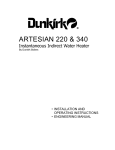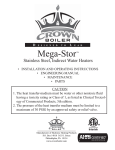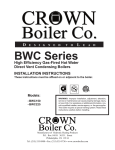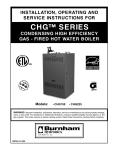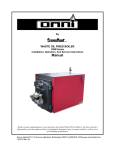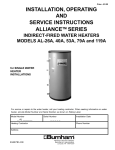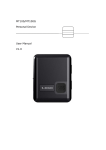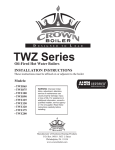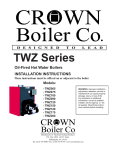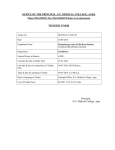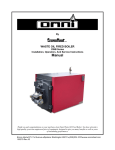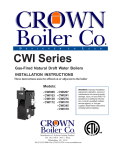Download Crown Boiler MT100G Operating instructions
Transcript
D E S I G N E D T O L E A D MAXI-THERM Glass Lined Indirect Water Heater INSTALLATION AND OPERATING INSTRUCTIONS Models: • MT040G • MT050G • MT079G • MT100G WARNING: Improper installation, adjustment, alteration, service or maintenance can cause property damage, injury, or loss of life. For assistance or additional information, consult a qualified installer or service agency. Read these instructions carefully before installing or using. Manufacturer of Hydronic Heating Products P.O. Box 14818 3633 I. Street Philadelphia, PA 19134 Tel: (215) 535-8900 • Fax: (215) 535-9736 • www.crownboiler.com CONTENTS I. II. III. Product Description......................................................................... 2 Specifications...................................................................................2 Designing A Maxi-Therm System......................................................4 “Quick” Residential..........................................................................5 Detailed Residential..........................................................................6 Commercial..................................................................................... 9 Zone Design.....................................................................................15 IV. Before Starting Installation...............................................................18 V. Locating the Maxi-Therm.................................................................18 VI. Piping.............................................................................................. 20 Boiler Side.......................................................................................20 Domestic Side..................................................................................24 VII. Wiring..............................................................................................30 VIII. Start-up........................................................................................... 34 IX. Maintenance.................................................................................... 35 X. Operating Instructions......................................................................36 XI. Parts................................................................................................ 37 Appendix A: Whirlpool Sizing......................................................................39 1 I. PRODUCT DESCRIPTION The Crown MT series indirect water heater is designed to generate domestic hot water in conjunction with a hot water boiler using forced boiler water circulation. This indirect water heater consists of an enameled steel tank in which a smooth coil is located. Boiler water is pumped through the coil and heats the water in the tank. The Maxi-Therm is not intended for use in heating any fluid other than water. It is also not intended for use in gravity hot water heating systems. IMPORTANT NOTE Some localities require indirect water heaters having a relief valve capacity in excess of 200,000 BTU/hr to be constructed and stamped in accordance with ASME requirements. Check with the local authority having jurisdiction before installing an MT079G or MT100G with a boiler having a total gross output in excess of 200,000 BTU/hr. II. SPECIFICATIONS Table 1: Specifications MAXI-THERM MT040G MT050G FIRST HOUR RATING (Gal/hr)* 192 225 BOILER OUTPUT (BTU/hr) 103,149 116,094 BOILER W ATER FLOW (Gal/min) 8.0 8.0 COIL HEAD LOSS (ft w.c.) 2.6 2.6 COIL SURFACE (sq. ft) 12.1 14.3 TANK VOLUME (Gal) 38.0 49.7 NET W EIGHT (lbs) 190 226 FILLED W EIGHT (lbs) 523 658 DIMENSIONS (in) A 5 1/8 5 1/8 B 9 3/4 9 3/4 C 34 37 7/8 D 62 3/4 E 50 1/2 CONNECTIONS (NPT) COLD/DRAIN 3/4 M 3/4 M BOILER SUPPLY 1F 1F BOILER RETURN 1F 1F HOT 3/4 M 3/4 M THERMOSTAT 3/4 F 3/4 F RECIRC. T & P VALVE 3/4 F 3/4 F MT079G 286 137,604 10.0 4.4 15.1 79.3 245 926 MT100G 400 200,038 10.0 5.7 25.8 101.7 310 1187 2 3/4 10 28 1/2 36 1/2 2 3/4 10 43 3/8 48 3/8 52 5/8 65 7/8 1M 1F 1F 1M 3/4 F 3/4 F 1F 1 1/4 M 1F 1F 1 1/4 M 3/4 F 3/4 F 1F * First Hour Ratings are based on 58F inlet water, 135F hot water, 180F boiler supply water 2 Figure 1a: MT040G and MT050G - General Configuration Figure 1b: MT079G and MT100G - General Configuration 3 III. DESIGNING A MAXI-THERM SYSTEM IMPORTANT The following procedures are used to size indirect water heaters based on the amount of hot water that will be required during a given hour. In doing so it is assumed that this demand will be evenly spread out over the course of the entire hour. THESE SIZING PROCEDURES ARE PROVIDED AS A GUIDE TO ASSIST THE PROFESSIONAL CONTRACTOR IN SIZING MAXI-THERMS. BECAUSE OF THE LARGE VARIETY OF DEMAND SITUATIONS ENCOUNTERED IN THE FIELD, CROWN BOILER COMPANY CANNOT GUARANTEE THE SUITABILITY OF THESE PROCEDURES TO ALL INSTALLATIONS. Three steps must be taken to properly design a Crown Maxi-Therm system: 1) Determine the domestic hot water requirements. 2) Select a Maxi-Therm / boiler combination 3) Select a pump, zone piping size, and control system to provide adequate and timely boiler water flow through the Maxi-Therm coil. This manual presents three methods of sizing Maxi-Therms: Method A: “Quick” Residential Method B: “Detailed” Residential Method C: Commercial NOTE For whirlpool (Jacuzzi) sizing see Appendix A 4 METHOD A: “QUICK” RESIDENTIAL Table 2 shows some typical applications into which many “residential” applications can be classified. This procedure will provide satisfactory results most of the time. Where greater accuracy is desired, use Method B. 1) Find the description that best fits the installation and select the Maxi-Therm called for. Also note the required boiler output under column (f). 2) The Maxi-Therm must be installed with a boiler having an output GREATER THAN OR EQUAL to that shown in column (f) of Table 2. If the Maxi-Therm is to be used with a boiler having an output LESS than that shown in Table 2, use Method B. a) If a new boiler is to be installed with the Maxi-Therm, first find a boiler that will handle the space heating load alone. If this boiler has an output GREATER than that shown in column (f), do not add anything to the size of the boiler selected for the Maxi-Therm. b) If the boiler required for space heating alone has an output LESS than that called for in column (f) of Table 2, increase the size of the boiler selected to one with an output equal to that shown in column (f). Table 2: Maxi-Therm “Quick Sizing” Table (a) (b) (c) (e) (f) Dishwasher (d) Clothes Washer Occupants Baths Maxi-Therm Boiler Output Small Office <10 ½-1* Yes Yes * MT040G 30,000 Apartment 1-2 1-1 ½ Yes Yes MT040G 80,000 House 1-3 1-1 ½ Yes Yes MT040G 80,000 House 3-5 2-2 ½ Yes Yes MT050G 116,000 Description *No showers. If a clothes washer is present, it is a residential model. 5 METHOD B: “DETAILED” RESIDENTIAL 1) Record the total number of each type of fixture in column (c) of Worksheet 1. If a whirlpool (Jacuzzi) is installed, record all fixtures EXCEPT the whirlpool faucet. 2) For each line multiply the quantity entered in column (c ) by the corresponding hourly usage in column (b). Enter the result in column (d). 3) Total column (d). This is the PEAK HOUR DEMAND. 4) Multiply the Peak Hour Demand by 1.20. This is the ADJUSTED PEAK HOUR DEMAND. 5) If a new boiler is to be installed with the Maxi-Therm: a) Go to Table 1 and select a Maxi-Therm which has a 135F First Hour Rating greater than or equal to the Adjusted Probable Maximum Demand calculated above. b) Use the appropriate graph in Figures 4a-4d to determine the boiler output needed to generate the required First Hour Rating. c) Determine the boiler size required to satisfy the space-heating requirement alone. Note the output of this boiler. d) Install the Maxi-Therm with a boiler having the larger of these two outputs. 6) If the Maxi Therm is to be installed with an existing boiler: a) Go to Table 1 and select a Maxi-Therm which has a 135F First Hour Rating greater than or equal to the Adjusted Probable Maximum Demand calculated above. b) Use the appropriate graph in Figures 4a-4d to find the First Hour Rating that can be expected with the boiler on the job. c) If this First Hour Rating is unacceptable, the existing boiler is too small. Depending on hot water usage pattern, the use of a larger Maxi-Therm may compensate for the undersized boiler. Consult a Crown Representative for additional guidance. 7) If a whirlpool is installed, see Appendix A. 8) See the Zone Design section of this manual for circulator sizing and other information on designing the Maxi-Therm zone. EXAMPLE 1: A Maxi-Therm is to be installed with a new boiler. The residence has the following fixtures: Bath #1: 7 GPM Shower Head Vanity Bath #2: 5 GPM Shower Head Vanity Kitchen: Kitchen Sink Automatic Dishwasher Laundry: Clothes Washer The heat loss of the house is 80,000 BTU/hr 6 WORKSHEET 1: SINGLE FAMILY RESIDENCE (a) (b) 135F WATER PER FIXTURE (Gal/hr) FIXTURE DESCRIPTION Shower: (3 GPM Head) (5 GPM Head) (7 GPM Head) Bath (30 Gal. Tub) Vanity Clothes Washer Dishwasher Kitchen Sink or Utility Tub (c) TOTAL NUMBER OF FIXTURES (d) 135F WATER PER TYPE OF FIXTURE (Gal/hr) 21.0 35.0 49.0 21.0 2.8 48.0 15.0 X X X X X X X = = = = = = = 10.0 X = Peak Hour Demand = Total Column (d) Peak Hour Demand X 1.20 = Adjusted Peak Demand = = 1) Boiler Output Required For Maxi-Therm = BTU/hr 2) Boiler Output Required for Space Heating = BTU/hr Select a boiler with an output equal to (1) or (2), whichever is GREATER SOLUTION: The completed Worksheet 1 for this example is shown in Figure 2. The Adjusted Peak Hour Demand is 195 Gallons per Hour. From Table 1 we see that a MT050G is required. Use Figure 4b to determine the boiler size required to achieve a 195 GPH First Hour Rating with an MT050G. From Figure 4b we see that a boiler output of approximately 102,000 BTU/hr is required. Install a boiler with a 102,000 BTU/hr output. 7 Figure 2: Completed Worksheet 1 and Boiler Output Graph From Example 1 WORKSHEET 1: SINGLE FAMILY RESIDENCE (a) (b) 135F WATER PER FIXTURE (Gal/hr) FIXTURE DESCRIPTION Shower: (3 GPM Head) (5 GPM Head) (7 GPM Head) Bath (30 Gal. Tub) Vanity Clothes Washer Dishwasher Kitchen Sink or Utility Tub (c) TOTAL NUMBER OF FIXTURES 21.0 35.0 49.0 21.0 2.8 48.0 15.0 X X X X X X X 10.0 X (d) 135F WATER PER TYPE OF FIXTURE (Gal/hr) 2 1 1 = = = = = = = 1 = 10.0 = = 162.6 195.1 1) Boiler Output Required For Maxi-Therm = 102,000 BTU/hr 2) Boiler Output Required for Space Heating = 80,000 BTU/hr 1 1 Peak Hour Demand = Total Column (d) Peak Hour Demand X 1.20 = Adjusted Peak Demand 35.0 49.0 5.6 48.0 15.0 Select a boiler with an Output equal to (1) or (2), whichever is GREATER FIRST HOUR RATING (GAL/hr) 250 200 150 100 50 0 0 50000 100000 BOILER OUTPUT (BTU/hr) Figure 4b: MT050G Ratings at Different Boiler Outputs 8 150000 METHOD C: COMMERCIAL 1) Table 3 shows demands for various fixtures found in commercial buildings in gallons per hour. To determine the hot requirements of the building: a) Using Worksheet 2, determine and record the total number of each type of fixture in the building under column (2). b) Use Table 3 to find the number of gallons of 135F water used per hour. Record this value per fixture in column (1). Hourly usage of some commercial kitchen fixtures is shown in Worksheet 2. c) Multiply each line in column (1) by the number in column (2). The result is the total amount of water used for each type of fixture per hour. Record this in column (3). d) Total column (3). The result is the total amount of water used by all fixtures per hour. This is the POSSIBLE MAXIMUM DEMAND. e) The demand factor shown in line 12 of Table 3 is intended to take into consideration the fact that not all fixtures will be in use at the same time. Multiply the total demand calculated in step (d) by this factor. The result is the PROBABLE MAXIMUM DEMAND. f) If a commercial dishwasher or laundry is on the job, determine the maximum amount of 135F water, which could be used in the hour. This will depend upon the number of machines, the amount of water used per machine, and usage pattern. Consult the machine manufacturer and the building owner for this information. Once the maximum hourly usage is known for this equipment, enter it in the spaces provided under Column (3). g) Add the hourly usage for dishwasher and washing machines to the Probable Maximum Demand. This is the ADJUSTED PROBABLE MAXIMUM DEMAND. 2) Select the Maxi-Therm: a) If a boiler is to be installed with the Maxi-Therm: • • • • Go to Table 1 and select a Maxi-Therm with a 135F First Hour Rating greater than or equal to the Adjusted Probable Maximum Demand calculated in (1g). Use the appropriate graph in Figures 4a-4d to determine the boiler output needed to generate the required First Hour Rating. Determine the boiler required to satisfy the space-heating requirement alone. Install the Maxi-Therm with a boiler having the larger of the above two outputs. b) If the Maxi-Therm is to be installed with an existing boiler: • • • Go to Table 1 and select a Maxi-Therm which has a 135F First Hour Rating greater than or equal to the Adjusted Probable Maximum Demand calculated in (1g). Use the appropriate graph in Figures 4a-4d to find the First Hour Rating that can be expected with the boiler on the job. If this First Hour Rating is unacceptable, the boiler on the job is too small. Depending on the hot water usage pattern, the use of a larger Maxi-Therm may compensate for the undersized boiler. Consult a Crown Representative for additional guidance. 9 3) Several Maxi-Therms may be used together if needed. If this must be done keep the following in mind: • • • • • The first hour rating of several Maxi-Therms may be added together to give a first hour rating for the total system. The boiler outputs for the individual Maxi-Therms must be totaled to provide the boiler output required for the system. The boiler water flow rate on which each individual Maxi-Therm’s First Hour Rating is based must be developed through the coil of each tank. Use Maxi-Therms of equal size (do not mix Maxi-Therms of different sizes on the same manifold). See the “Piping” and “Wiring” sections of this manual for proper installation of a manifold system. 4) Before settling on the choice of Maxi-Therm made above, keep in mind the following: • Many building’s peak demands result from the constant use of one type of fixture or machine for a relatively short period of time (showers in a gymnasium, for example). The procedure outlined above may not provide adequate hot water in these cases. The best way to size Maxi-Therm for this type of application is to determine the total flow rate of all fixtures which are, or could be, in use at once and select a Maxi-Therm from Table 4 which will provide hot water at this flow rate for the period of time required. • Crown does not recommend the use of a Maxi-Therm to generate 180F water for commercial dishwashers. Use the Maxi-Therm to generate 135F water and a pre-heater to raise the water temperature for the dishwasher to 180F. Example 2 (Commercial): A Maxi-Therm is to be sized for a motel with 20 rooms. Each of these rooms has the following fixtures: (1) (1) (1) Vanity Shower Bath In addition, 5 rooms have an additional vanity. Also there is utility sink used by the staff for cleaning and a laundry with two machines. Solution: Use Table 3 and the fixture count to complete Worksheet 2 (Fig.3) Note that the vanities are treated as “Private Lavatory Basins” and the utility tub as a “Laundry Tub”. From discussions with the washing machine manufacturer and the motel owner, it is found that 100 gal/hr of 135F water is used in the laundry. This usage is recorded on the “Laundry Line” at the bottom of Worksheet 2. The demand factor of 0.25 for a Hotel is on line 12 of Table 3. The Probable Maximum Demand is 0.25 x 1978 = 494.5 Gal./hr. To this we add the 100 Gal/hr Demand of 594.5 Gal./hr. Select the most cost-effective combination of equal size Maxi-Therms which will satisfy this requirement. The total gross boiler output required is equal to the requirement for each Maxi-Therm multiplied by the total number of Maxi-Therms installed on the zone. Total boiler water flow through the Maxi-Therm zone is equal to the requirement for each Maxi-Therm times the total number of Maxi-Therms. 10 WORKSHEET 2: COMMERCIAL SIZING (1) 135F WATER PER FIXTURE (Gal/hr) Fixture Description: Basins, Private Lavatory Basins, Public Lavatory Bathtubs Showers Circular Wash Sinks Semi Circular Wash Sinks Foot Basins Laundry, Stationary Tubs Kitchen Sink Dishwasher in Apartment Clothes Washer in Apartment Commercial Kitchen Fixtures: Vegetable Sink Single Pot Sink Double Pot Sink Triple Pot Sink Bar Sink (2) (3) 135F WATER PER TYPE OF FIXTURE (Gal/hr) TOTAL NUMBER OF FIXTURES 15 48 X X X X X X X X X X X = = = = = = = = = = = 45 30 60 90 30 X X X X X = = = = = Total Column (3) Possible Maximum Demand Demand Factor Probable Maximum Demand Hourly Dishwasher Requirement Hourly Laundry Requirement Adjusted Probable Maximum Demand = X = + + = Table 3: Hot Water Demand for Fixtures in Various Types of Buildings Fixture: 1. Basins, Private Laundry 2. Basins, Public Lavatory 3. Bathtubs 4. Foot Basins 5. Kitchen Sink 6. Laundry Tubs 7. Pantry Sink 8. Showers 9. Service Sink 10. Circular W ash Sinks 11. Semicircular W ash Sinks 12. Demand Factor Apartment House 2 4 20 3 10 20 5 30 20 Club 2 6 20 3 20 28 10 150 20 Gym 2 8 30 12 0.30 0.30 0.40 225 11 Hotel 2 8 20 3 30 28 10 75 30 20 10 0.25 Industrial Plant 2 12 Office Building 2 6 School 2 15 12 20 20 3 20 225 20 30 15 0.40 10 30 20 20 10 0.30 10 225 20 30 15 0.40 Figure 3: Use of Worksheet 2 and Boiler Output Graphs From Example 2 WORKSHEET 2: COMMERCIAL SIZING Fixture Description: (1) 135F WATER PER FIXTURE (Gal/hr) (2) (3) 135F WATER PER TYPE OF FIXTURE (Gal/hr) TOTAL NUMBER OF FIXTURES Basins, Private Lavatory Basins, Public Lavatory Bathtubs Showers Circular Wash Sinks Semi Circular Wash Sinks Foot Basins Laundry, Stationary Tubs Kitchen Sink Dishwasher in Apartment Clothes Washer in Apartment 15 48 X X X X X X X X X X X Commercial Kitchen Fixtures: Vegetable Sink Single Pot Sink Double Pot Sink Triple Pot Sink Bar Sink 45 30 60 90 30 X X X X X = = = = = Total Column (3) Possible Maximum Demand Demand Factor Probable Maximum Demand Hourly Dishwasher Requirement Hourly Laundry Requirement Adjusted Probable Maximum Demand = X = + + = 2 20 75 28 25 20 20 1 = = = = = = = = = = = 50 400 1500 28 1978 0.25 494.5 0 100 594.5 FIRST HOUR RATING (GAL/hr) 250 200 150 100 50 0 0 50000 100000 BOIL ER OUT PUT (BT U/h r ) Figure 4a: MT040G Ratings at Different Boiler Outputs 12 150000 FIRST HOUR RATING (GAL/hr) 250 200 150 100 50 0 0 50000 100000 150000 BOILER OUTPUT (BTU/hr) FIRST HOUR RATING (GAL/hr) Figure 4b: MT050G Ratings at Different Boiler Outputs 350 300 250 200 150 100 50 0 0 50000 100000 150000 BOILER OUTPUT (BTU/hr) Figure 4c: MT079G Ratings at Different Boiler Outputs 13 200000 FIRST HOUR RATING (GAL/hr) 450 400 350 300 250 200 150 100 50 0 0 50000 100000 150000 200000 250000 BOILER OUTPUT (BTU/hr) Figure 4d: MT100G Ratings at Different Boiler Outputs Table 4: 135F Water Available at Various Flow Rates Starting with a Fully Recovered Maxi-Therm Model MT040G Time (min.) Gallons. MT050G Time (min.) Gallons. MT079G Time (min.) Gallons. MT100G Time (min.) Gallons. Boiler Output (BTU/hr) 3.0 5.0 Draw Rate (GPM) 7.5 9.0 11.9 35.6 6.8 33.9 4.2 31.2 3.2 29.2 103149 Ind. 9.3 46.7 5.7 42.8 4.5 40.9 116094 Ind. 13.2 65.8 8.5 64.0 6.1 54.8 3.8 46.2 2.5 37.3 137604 Ind. Ind. 10.6 79.3 8.4 75.2 5.7 68.1 4.0 59.4 200038 12.0 15.0 Notes: 1) “Time (min.)” – The time water may be drawn from a fully recovered tank before the outlet temperature falls 25 degrees. 2) “Gallons” – The total volume of water drawn from the tank during this time. 3) "Ind."- Draw may be made at this flow rate indefinitely with the outlet temperature falling less than 25 degrees from the outlet temperature at the beginning of the draw. 4) All valves shown are approximate. 14 Zone Design In designing the Maxi-Therm zone piping system the following points should be considered: 1) Circulator or Zone Valve Zoning? – Circulator zones are usually a better choice. Zone valves have a relatively high pressure drop at the flow rate required through the Maxi-Therm (see Table 1). 2) If zone valves are selected, use a zone valve with a minimal delay in opening, such as a motorized type. 3) Priority Zoning – Priority zoning is used to divert all boiler output to the Maxi-Therm when its zone calls for heat regardless of any simultaneous calls for heat from space heating zones. Priority zoning can be done using a 3-way zone valve, or by using a relay to de-energize the heating zones when the Maxi-Therm calls for heat. See the Piping and Wiring Sections for more information on priority zone systems. 4) Use Worksheet 3 to size piping and select a circulator for the Maxi-Therm zone. To do this: a) Use column (1) to enter the total number of each type of fitting. For straight pipe enter the total number of feet. When counting fittings, count all fittings in the Maxi-Therm zone as well as all fittings in the piping common to all zones (zone manifolds, etc.) b) For MT040G and MT050Gs use the fitting pressure drops in column (2). For MT079G and MT100Gs use the fitting pressure drops in column (3). c) For each fitting, multiply the quantity of the fitting in column [1] by the appropriate pressure drop in column (2) or (3). Enter the result in column (4). d) Total column (4). This is the total pressure drop for the Maxi-Therm zone. e) Use Table 5 or a circulator manufacturer’s literature to select a circulator, which will develop the required flow rate at the pressure drop calculated. Example 3: Size a circulator for a zone with a MT040G and the following pipe and fittings: 10 ft 1” Straight Pipe 6 ft 1-1/4” Straight Pipe 6 1” 90 Els 3 1-1/4” 90 Els 1 Run of 1-1/4” Tee 2 Branch of 1-1/4” Tee 1 Taco #220 1” “Flo-Chek” 1 Taco #432 1-1/4 Air Scoop The boiler is cast iron and has a minimal pressure drop. 1) Using Worksheet 3, record the total number of fittings in Maxi-Therm zone and piping common to all zones (piping shown in bold in column (1)). Figure 4 shows a completed worksheet for this example. 2) Since 8 GPM is required, use the pressure drops shown in column (2). Multiply each entry in column (1) by the corresponding pressure drop in column (2). Enter the result in column (3). 3) The total of column (4) is 7.3ft. of head. This is the total pressure drop for the Maxi-Therm zone. 4) Select a pump, which will develop 7.3ft. of Head at 8 GPM. From Table 5, we see that either a Taco 007 or a Grundfos UPS 15-42F can be used. 15 WORKSHEET #3: Pressure Drop Calculations Through Maxi-Therm Zone (1) Fitting Description MT040G Coil MT050G Coil MT079G Coil MT100G Coil 1 ft 1" St. Pipe 1 ft 1-1/4" St. Pipe 1 ft 1-1/2" St. Pipe 1" 90 El 1-1/4" 90 El 1-1/2" 90 El 1" Run of Tee 1-1/4" Run of Tee 1-1/2" Run of Tee 1" Branch in Tee 1-1/4" Branch in Tee 1-1/2" Branch in Tee 1" Std. Ball Valve 1-1/4" Std. Ball Valve 1-1/2" Std. Ball Valve Taco "Flo-Chek": #220 (1") #220 (1-1/4") #222 (1-1/2") Taco "Air Scoop": #431 (1") #432 (1-1/4") Honeywell V8043F1101 Zone Valve (Cv = 8) Allowance for Bushings and Sudden Transitions (*) Boiler (**) Quantity 1 (2) (3) Pressure Drop (ft head) at: 8 Gal/min 10 Gal/min 2.60 2.60 4.40 5.70 0.05 0.08 0.02 0.03 0.01 0.02 0.16 0.25 0.06 0.09 0.04 0.06 0.05 0.08 0.02 0.03 0.01 0.02 0.26 0.41 0.08 0.13 0.05 0.08 0.12 0.19 0.06 0.09 0.02 0.03 2.18 0.84 0.44 3.41 1.31 0.69 0.15 0.05 0.23 0.08 2.31 3.61 0.53 0.83 (4) Total Total Head Loss Through Manifold Piping and Maxi-Therm Zone = Notes: * Includes (2) 1-1/2 x 3/4 Bushings and (2) 1-1/2 x 1 Transitions ** The Pressure Drop Through Most Cast Iron and Steel Boilers can be Ignored 16 ft wc. Table 5: Selecting a Circulator Available Head (ft w.c.) 8.0 Gal/min 10.0 Gal/min 8.2 7.3 9.8 7.2 22.8 21.0 11.0 9.0 21.0 19.5 23.0 21.0 Circulator Taco007 Taco 008 Taco 0011 Grundfos UPS 15-42F Grundfos UPS 26-64F Grundfos UPS 26-96F Figure 4: Example of Use of Worksheet 3 WORKSHEET #3: Pressure Drop Calculations Through M axi-Therm Zone [a] Fitting Des cription MT040G Coil MT050G Coil MT079G Coil MT100G Coil 1 ft 1" St. Pipe 1 ft 1-1/4" St. Pipe 1 ft 1-1/2" St. Pipe 1" 90 El 1-1/4" 90 El 1-1/2" 90 El 1" Run of Tee 1-1/4" Run of Tee 1-1/2" Run of Tee 1" Branch in Tee 1-1/4" Branch in Tee 1-1/2" Branch in Tee 1" Std. Ball Valve 1-1/4" Std. Ball Valve 1-1/2" Std. Ball Valve Taco "Flo-Chek": #220 (1") #220 (1-1/4") #222 (1-1/2") Taco "Air Scoop": #431 (1") #432 (1-1/4") Honeywell V8043F1101 Zone Valve (Cv = 8) Allowance for Bus hings and Sudden Trans itions (*) Boiler (**) Quantity 1 10 6 6 3 1 2 1 1 1 1 [b] [c] Pres s ure Drop (ft head) at: 8 Gal/min 10 Gal/min 2.60 2.60 4.40 5.70 0.08 0.05 0.03 0.02 0.01 0.02 0.25 0.16 0.09 0.06 0.04 0.06 0.05 0.08 0.03 0.02 0.01 0.02 0.26 0.41 0.13 0.08 0.05 0.08 0.12 0.19 0.06 0.09 0.02 0.03 2.18 0.84 0.44 3.41 1.31 0.69 0.15 0.05 0.23 0.08 2.31 3.61 0.53 0 0.83 Total Head Los s Through Manifold Piping and Maxi-Therm Zone = [d] Total 2.60 0.50 0.12 0.96 0.18 0.02 0.16 2.18 0.05 0.53 0 7.30 Notes : * Includes (2) 1-1/2 x 3/4 Bus hings and (2) 1-1/2 x 1 Trans itions ** The Pres s ure Drop Through Mos t Cas t Iron and Steel Boilers can be Ignored 17 ft wc. IV. BEFORE STARTING INSTALLATION 1) Be sure that the planned installation is in accordance with all local codes. Also note that some jurisdictions may not permit the installation of an MT079G or MT100G with a boiler having a gross output in excess of 200,000 BTU/hr. Consult the authority having jurisdiction before installing a MT079G or MT100G with a boiler having an output in excess of 200,000 BTU/hr. 2) Read and understand all installation requirements in this manual. V. LOCATING THE MAXI-THERM WARNING • Failure to properly support a Maxi-Therm could result in property damage or personal injury. • Some localities may require this product to be braced, anchored, or strapped to prevent it falling or moving during an earthquake. Consult the state or local authority having juridication for more information. CAUTION Install the Maxi-Therm in a location where a leak in the tank, the connected piping, or an open T & P valve will not damage the area adjacent to the heater or to lower floors of the structure. When such locations cannot be avoided, install the MaxiTherm in a suitable drain pan connected to an adequate drain. This drain pan should have a length and width at least 2” greater than the diameter of the Maxi-Therm. IMPORTANT Avoid rough handling when moving the Maxi-Therm to its final location. Rough handling could damage the protective lining inside the tank . 1) Table 1 shows the weights of all Maxi-Therms filled with water. Make sure that the location chosen for the MaxiTherm is capable of supporting it. 2) Observe the recommended clearances shown in Figure 5. These clearances are needed to access the anode rod and hand hole cover gasket for inspection and maintenance. The anode rod is located in the hand hole cover on the MT040G and MT050G, so there is only a clearance requirement on the top of the Maxi-Therm. All clearances not shown in Figure 5 are 0”. 18 3) The Maxi-Therm may be located some distance from the boiler provided the zone system is designed to provide the flow called for in Table 1 through the coil. Also, the further the Maxi-Therm is from the boiler, the longer the response of the boiler will be to a call from the Maxi-Therm zone. If long runs exist between the boiler and Maxi-Therm, it is advisable to insulate the piping. MODEL "X" "Y" MT040G 0 12* MT050G 0 12* MT079G 24 18 MT100G 24 22 * Additional clearance may be required for hot water piping Figure 5: Required Access Clearances 19 VI. PIPING CAUTION Do not connect a Maxi-Therm to a boiler system having a significant amount of make up water or radiant tubing without an oxygen barrier. Doing so may cause premature failure of the Maxi-Therm coil. WARNING Install a relief valve on the boiler per the boiler manufacturer’s instructions. Also refer to the boiler manufacturer’s instructions and the authority having jurisdiction for other possible boiler-side piping requirements, such as low water cut-offs or flow switches. The following illustrations are intended to illustrate zone piping; they are not comprehensive boiler piping instructions. BOILER SIDE PIPING Figures 6-11 show typical boiler side piping for several common situations. Regardless of which system is used, it is imperative that the flow rates called for in Table 1 are developed through the coil. This requires properly sized piping and a properly sized pump. To determine the pipe/pump sizes required see Part III. The systems shown in Figures 6-11 are described below: STANDARD CIRCULATOR ZONE This system is just like a straight heating circulator zone system except that one of the zones goes to the Maxi-Therm coil instead of radiation. As on any circulator zone system, control valves should be installed in each zone to prevent unwanted circulation through zones which are not calling for heat. Figure 6 illustrates typical circulator zone piping. ZONE VALVE SYSTEM As with the circulator zone system, this system is just like a standard heating zone system except that one of the zones is connected to the Maxi-Therm coil. The circulator must be large enough to move boiler water through the coil at the flow rate in Table 1, regardless of the flow rate required through the heating zones. Figure 7 illustrates a typical zone valve system. 3-WAY ZONE VALVE SYSTEM This system offers a simple method of prioritizing the Maxi-Therm. In this system a 3-way zone valve is used which has a “common” port, a “normally open” port, and a “normally closed” port. The zone valve motor is wired so as to be energized by the Maxi-Therm thermostat (see Part VII for wiring information). The common side of the zone valve is connected to the boiler. The heating zone is connected to the normally open side of the zone valve and the Maxi-Therm coil is connected to the normally closed side of the zone valve. As long as the Maxi-Therm is not calling for heat, boiler water can flow from the space-heating zone, through the normally open side of the 3-way valve, to the boiler. As soon as the Maxi-Therm calls for heat, the zone valve is energized, and boiler water can only flow through the Maxi-Therm zone. Figure 8 illustrates a typical 3-way zone valve system. 20 Figure 6: Boiler-Side Piping Using Circulator Zones Figure 7: Boiler-Side Piping Using Zone Valves (2-Way) 21 RADIANT PANEL OR OTHER “LOW TEMPERATURE” SYSTEM The First Hour Ratings published in this manual are based on a boiler supply temperature of 180F. If, for any reason, the boiler water temperature going to the heating system is held to levels under 180F, special piping is needed to provide boiler water to both the Maxi-Therm and the heating system at the proper temperatures. Two ways of doing this are with a heat exchanger or a 4-way valve. In either system, the Maxi-Therm must be connected to the boiler before any means are used to control the temperature of the water going to the system. The temperature of the water going through the Maxi-Therm coil is thus limited only by the boiler high limit setting, which should be set at 180F or higher. Figure 9 illustrates the use of a heat exchanger to control the temperature of the water going to the “low temperature” system. The low temperature system water is completely isolated from the water passing through the boiler and Maxi-Therm. For this reason, the low temperature system must be equipped with its own expansion tank, fill, and air removal apparatus. The temperature in this system may be controlled through the use of an aquastat in the low temperature side. Figure 10 illustrates the use of a 4-way valve to control maximum heating zone temperature while allowing 180F boiler water to enter the Maxi-Therm zone. The four way valve may be manually set to provide the maximum allowable temperature to the heating zone or it may be provided with a motor to control the valve in response to some parameter (outdoor temperature for example). MAXI-THERM MANIFOLD PIPING (BOILER SIDE) Multiple Maxi-Therm installations must be done in the “reverse-return” manner illustrated in Figure 11. The reason for this is to create the same pressure drop (and therefore the same flow) through the coil of each MaxiTherm. The boiler manifold piping must be sized so that each coil has the flow rate called for in Table 1. For example, if two MT040G’s are to be manifold together, the circulator and zone piping common to both tanks must be capable of moving 16 GPM (2 x 8 GPM) Because the pressure drop through Maxi-Therm coils varies from size to size, it is hard to predict the flow rate that will be developed through each coil when two Maxi-Therms of different sizes are placed in the same manifold. For this reason it is best not to mix Maxi-Therms of two different sizes in the same zone. Figure 8: Boiler-Side Piping a 3-Way Zone Valve 22 Figure 9: Boiler-Side Piping in a Low Temperature System Using a Heat Exchanger Figure 10: Boiler-Side Piping in a Low Temperature System Using a Mixing Valve 23 Figure 11: Boiler-Side Piping for Multiple Maxi-Therms DOMESTIC SIDE PIPING BASIC DOMESTIC PIPING Figure 12 shows typical domestic water piping for a Maxi-Therm. All components except the thermostat are provided by the installer. The function of the components shown are as follows: a) Thermostat (required) - This control is provided by Crown and must be installed in the location indicated. It is imperative that the bulb of the thermostat is “bottomed out” in the control well. This thermostat controls the temperature of the domestic water. b) Shut-off valves (recommended) -Used to isolate the tank for servicing. c) Backflow Preventer (required by some codes) - Use to prevent water from backing out of the MaxiTherm in the event that inlet water pressure drops. d) Expansion Tank (required when a backflow preventer is used) - This expansion tank absorbs the increased volume caused by heating water. If a backflow preventer is installed, this expansion tank is required because the increased water volume will otherwise have no place to go and the T & P valve will open. Use an expansion tank designed for use on domestic water systems such as Watts DET series. Consult the expansion tank manufacturer’s literature for the proper size expansion tank to use. IMPORTANT If an expansion tank is used, do not put any valves between the expansion tank and Maxi-Therm inlet. 24 e) Dielectric Unions (recommended)- Used to electrically isolate the Maxi-Therm from the connected domestic water piping. This helps to minimize the possibility of corrosion damage to the Maxi-Therm. On the 40 and 50 gallon sizes, the hot water outlet is located in the clean out cover along with the anode rod. The union in the hot water connection simplifies inspection of the anode rod. f) Drain (required)- Used to drain the tank for inspection or servicing. g) Temperature / Pressure Relief Valve (required) - Opens to relieve excess pressure or temperature which has developed in the Maxi-Therm. WARNING Install a new Temperature and Pressure Relief (“T & P”) Valve in the tapping on the top of the Maxi-Therm marked “T&P VALVE”. Failure to do so could result in property damage, personal injury or death. • • • • • • • • This Valve must comply with the Standard for Relief Valves and Automatic Gas Shutoff devices for Hot Water Supply Systems (ANSI Z21.22) No valve is to be placed between the T&P valve and the Maxi-Therm Do not install valves, reducing couplings or other obstructions in the relief valve discharge line. Do not install a T&P valve with a pressure setting in excess of 150 psi or a temperature setting in excess of 210F See Table 6 for T&P Valve capacity sizing Pipe the discharge line to a location where hot water discharge will not cause injury or damage. Do not run any portion of the discharge line through a location that will be exposed to freezing temperatures. Pipe the discharge line to allow complete drainage of both the discharge piping and the T & P valve. h) Vacuum Breaker (Recommended)- this valve protects the tank in the event that the pressure in the tank falls below atmospheric and aids in draining the tank. Use a Watts N-36 or equivalent. i) Heat Trap (Optional) - The heat trap retards the migration of heat from the Maxi-Therm up the hot water supply pipe. TABLE 6: MINIMUM T&P VALVE SIZES * If the Maxi-Therm is connected to a boiler with a Gross Output LESS than the “Max. T&P Valve Capacity” shown below, install a T&P valve having a capacity greater than or equal to the boiler’s Gross Output. * If the Maxi-Therm is connected to a boiler with a Gross Output GREATER than the “Max. T&P Valve Capacity” shown below, install a T&P valve having a capacity greater than or equal to the “Max T&P Valve Capacity”. MODEL MT040G MT050G MT079G MT100G MAX. T&P VALVE CAPACITY 140400 154200 201400 310000 25 MAXI-THERM PIPING WITH A“MIXING VALVE” Usually, the maximum temperature of the outlet water will stay near the setting of the Maxi-Therm thermostat. In some cases, however, hot water usage patterns can cause the outlet water temperature to rise significantly above the control setting. The temperature of water going to the fixtures may be more carefully controlled through the use of a mixing valve. This device blends a controlled amount of cold water with the hot water from the Maxi-Therm to provide a more constant temperature at the fixtures. Typical mixing valve piping is illustrated in Figure 13. WARNING A mixing valve does not eliminate the risk of scalding: • • • Set the Maxi-Therm thermostat as low as practical. Feel water before bathing or showering. If anti-scald or anti-chill protection is required, use devices specifically designed for such service. Install these devices in accordance with their manufacturer’s instructions. DOMESTIC WATER PIPING FOR DISTANT FIXTURES In some cases the furthest fixture may be quite distant from the Maxi-Therm. In such an installation the configuration shown in Figure 12 or 13 would result in an unacceptable delay before hot water reaches these distant fixtures. Even if all the fixtures are relatively close to the Maxi-Therm, the building owner may want hot water at all fixtures as soon as they are opened. Figure 14 illustrates a solution to this problem. In it, a pipe is run from the furthest fixture on each branch back to the return of the Maxi-Therm. A small bronze circulator is mounted in this line and is wired so as to run continuously. A check valve in this line permits flow towards the Maxi-Therm inlet only. When no fixtures are drawing water, the bronze circulator moves hot water from the Maxi-Therm to end of the branch just below the last fixture, then back to the inlet of the Maxi-Therm via the return pipe. When a fixture is opened, hot water is already out in the branch very close to the fixture and hot water appears at it almost immediately. The check valve prevents cold water in the Maxi-Therm’s inlet pipe from passing around the tank and heading directly to the fixture. Because hot water is always circulated in the hot water branch, the entire branch should be insulated to prevent excessive heat loss. MANIFOLD DOMESTIC WATER PIPING Figure 15 illustrates the recommended method of piping the domestic water side of several tanks together. All Maxi-Therms are piped in a “reverse-return” manner just like the boiler piping. This balances the pressure drop through each tank, resulting in an even flow rate through each tank. Each tank must have its own T&P valve. It is recommended that each tank be equipped with its own isolation valves, unions, and drains so that one tank may be removed from the system. VII. WIRING 26 Figure 12: Basic Domestic-Side Piping Figure 13: Domestic-Side Piping Using a Mixing Valve 27 Insulate dashed piping Figure 14a: Domestic-Side Piping Using a Recirculation Line (MT040G, MT050G) Insulate dashed piping Figure 14b: Domestic-Side Piping Using a Recirculation Line (MT079G, MT100G) 28 Figure 15: Domestic-Side Piping for Multiple Maxi-Therms 29 The following general notes apply to all wiring: 1) Wiring must be done in accordance with all codes. In the absence of any codes, the system must be wired in accordance with the National Electric Code (ANSI/NFPA 70-latest edition). 2) The control system for the boiler, Maxi-Therm, and heating zones must be on a dedicated circuit. The current rating of this circuit will depend on the total number and size of loads in the system, however it should in no case be less than 15 AMPS. 3) The Maxi-Therm is equipped with Honeywell L4006A series thermostat. This thermostat has a set of contacts, which make upon a call for domestic water and break when this temperature is satisfied. CIRCULATOR ZONE WIRING (NON PRIORITY) Figure 16 is a connections diagram for a non-priority circulator zone system using Honeywell R845A’s. The R845A is equipped with two sets of contacts (3,4, and 5,6) which become made when the T and T terminals are made. Terminals 1 and 2 on the R845A are supplied with 110 VAC to power its internal transformer. In this application, one R845A is provided for each zone including that of the Maxi-Therm. If the boiler has a factory-equipped circulator, this is disconnected from the circulator terminals on the boiler. When any thermostat (including the thermostat on the Maxi-Therm) calls for heat, the relay in the R845A for that zone becomes energized. Terminals 3 and 4 become “made”, energizing the circulator. Terminals 5 and 6 are also made which start the boiler. CIRCULATOR ZONE WIRING (PRIORITY) Figure 17 is a connections diagram for priority circulator zoning. This system is similar to non-priority circulator zoning, except that a Honeywell R8285B fan center is used in place of the R845A on the Maxi-Therm zone. This fan center consists of a DPDT relay and a 24 volt transformer. The Maxi-therm control is connected to terminals R and G so that when the Maxi-therm control calls for heat the relay is energized. One set of contacts on the R8285B is used to switch line voltage. On this set of contacts, the common is connected to an unswitched “hot”. The normally closed contact is connected to terminal #1 on each of the space heating zone’s R845A’s. The normally open contact is connected to the Maxi-therm zone circulator. The normally closed contact on the other set of R8285B contact is not used. The common and normally open contacts are connected in parallel with terminals #5 and #6 on the space-heating zone R845A’s. As long as the Maxi-therm zone does not call for heat, the R845As for the heating zones have 110 VAC across their 1 and 2 terminals and the heating zones will function as described in the non-priority circulator zone section. As soon as the Maxi-therm calls for heat, however, the normally closed terminals in the R8285B open, de-energizing the heating zones and energizing the Maxi-therm circulator. The other set of contacts in the R8285B (connected across the boiler thermostat connections) become “made”, which brings on the boiler. ZONE VALVES (NON PRIORITY) Figure 18 is a connections diagram for a zone system using Honeywell V8043F motorized zone valves. The motor on these valves is connected between TH and TR. TH/TR is provided for the electrician’s convenience as a binding post and is not connected to anything inside the valve. The “endswitch” terminals are connected to a set of switch contacts inside the valve, which become made when the valve is open. A call for heat from any thermostat or the Maxi-therm aquastat results in the application of 24-volts across the motor in that zone’s zone valve. This drives open the zone valve. When the valve has opened, the endswitch in that zone valve makes and brings on the boiler. 30 Figure 16: Non-Priority Circulator Zoning Using Honeywell R845a’s Figure 17: Priority Circulator Zoning 31 ZONE VALVES (2-WAY PRIORITY) Figure 19 is a connections diagram for a priority zone system using Honeywell V8043F motorized valves. An R8285B relay is used which is equipped with its own transformer and a set of SPDT contacts. The Maxi-Therm control is connected to terminal R and G on the R8285B so that when the Maxi-Therm control calls for heat, the relay coil is energized. One side of the transformer is connected to the common contact. The normally closed contact is connected to all space heating thermostats. The normally open contact is connected directly to the Maxi-Therm zone valve motor. As long as the Maxi-Therm is not calling for heat, power is supplied to all space heating thermostats and a call from any space heating thermostat will energize that zone’s zone valve and bring on the boiler. As soon as the Maxi-Therm calls for heat, however, the normally closed contacts, which supply all power to the space heating thermostats, open. This de-energizes the heating zones and closes any open space heating zone valves. At the same time, the normally open contacts in the R8285B become made which energizes the MaxiTherm zone valve. The Maxi-Therm zone valve opens and its endswitch brings on the boiler. If four or fewer zones (including the Maxi-Therm zone) are present, the transformer in the R8285B may be used instead of an external transformer. Use terminals R and C with C being the “common” side of the 24-volt wiring. ONE VALVE (3-WAY PRIORITY) Figure 20 is a connection diagram for a Honeywell 3-way zone valve. As long as the Maxi-Therm is not calling for heat, a call from the space heating thermostat will start the boiler and water will circulate to the space heating zone through the normally open port of the zone valve (see the piping section for more information on this). If the Maxi-Therm thermostat calls for heat, however, the zone valve motor is energized and all boiler water is redirected through the Maxi-Therm coil regardless of the status of the space-heating thermostat. MANIFOLD WIRING Wiring for manifolded Maxi-Therms is identical to wiring for a single Maxi-Therm except for the presence of more than one tank aquastat. If the Maxi-Therms are piped together as shown in the Piping Section, only one thermostat should be needed and it can be installed in the thermostat location on any Maxi-Therm. Figure 18: Zone Valve Wiring (2-Way, Non Priority) 32 Figure 19: Zone Valve Wiring (2-Way, Priority) Note: Connect Zone Valve Port “A” to Maxi-Therm, Port “B” to Heating Zone, “AB” to boiler return Figure 20: Zone Valve Wiring (3-Way, Priority Using Honeywell V8044E1101 ) 33 VIII. START-UP 1) Make sure that the system is free of leaks and that air is purged from the system. 2) After completing all domestic water connections, flush the domestic side of the Maxi-Therm thoroughly before leaving the installation. Flushing the domestic water side of the Maxi-Therm will minimize the presence of WARNING Never attempt to fill a hot empty boiler. IMPORTANT Fix any leaks found before proceeding further. Leakage from the boiler piping could result in severe damage to the Maxi-Therm, boiler, and other system components. residual soldering flux in the Maxi-Therm tank and new piping. This is particularly important if the Maxi-Therm will be unused for an extended period of time after installation. Flush the Maxi-therm by drawing at least three times its volume from any convenient hot water fixture. 3) Make sure that all electrical connections are correctly made and that no exposed high voltage wiring is present. 4) Turn off the burner. 5) Make sure that each zone valve or circulator operates when, and only when, its thermostat calls for heat. Let each zone operate long enough to purge any remaining air from the system. 6) Set the Maxi-Therm thermostat to the desired position. Because hot water presents a scald hazard, it is best to set the thermostat at 120F or lower and raise it only if necessary to provide adequate hot water. WARNING Water Temperatures over 125°F can cause severe burns instantly or death from scalds. 7) Turn on the burner and allow the Maxi-Therm zone to operate. Make sure that the Maxi-Therm aquastat shuts down the zone when it is satisfied. 34 IX. MAINTENANCE The Maxi-Therm is an extremely simple device and as such requires very little maintenance. There are, however, several items that should be checked out on an annual or as needed basis to ensure a reliable supply of hot water: 1) On an annual basis, remove the jacket cover over the hand hole and make sure that the hand hole gasket is leak-tight. On the 40 and 50 gallon sizes, this hand hole is located on the top of the Maxi-Therm and is accessed by removing the two screws holding the cover to the top of the Maxi-Therm. On the 79 and 100 gallon sizes, the hand hole is located on the lower side of the Maxi-Therm. 2) Make sure that the rest of the boiler and domestic water piping is free of leaks. 3) If there is an oil-lubricated circulator in the system, make sure that it is lubricated as called for by the circulator manufacturer. 4) The Maxi-Therm depends upon the boiler for a source of heat and is therefore only as reliable as the boiler. Make sure that the boiler is maintained in accordance with the boiler manufacturer’s instructions. 5) All Maxi-Therms are equipped with a sacrificial anode rod. This anode rod helps to protect the Maxi-Therm from corrosion. This anode rod should be inspected periodically and replaced if more than half of the anode has been corroded away at any point in its length. The rate at which the anode rod will deteriorate will depend upon the quantity and chemistry of the water passing through the tank. In general, an annual inspection of the anode rod is appropriate. IMPORTANT For the anode rod to work properly it must be electrically bonded to the Maxi-Therm Tank. On the MT040G and MT050G, this is done with two ground wires that bond the anode rod to the clean-out cover and the clean-out cover to the tank. • Whenever the anode rod or clean out cover is serviced on the MT040G or MT050G, be sure that these ground wires are reconnected. • On the MT079G and MT100G these wires are not used; the anode rod is bonded to the tank through the anode rod thread. When inspecting the anode rod, do not use teflon tape on the anode rod threads. Failure to follow these precautions could result in premature failure of the tank. 6) On an annual basis, check the operation of the Temperature and Pressure Relief Valve by lifting the lever on the top of the valve and confirming that water is released. . CAUTION Stay away from the T&P Valve discharge piping when performing this check to avoid contact with hot water. Also make sure that water from the discharge will not damage property before performing this test. 35 X. OPERATING INSTRUCTIONS WARNING There are no user serviceable parts on this product. Attempts to service this product by someone other than a licensed plumber or heating technician could void the warranty, cause property damage, personal injury or loss of life. DANGER • Water temperature over 125°F can cause severe burns instantly or death from scalds. • Children, disabled and elderly are at highest risk of being scalded. • Set the Maxi-Therm thermostat as low as practical. Setting the thermostat as low as possible will reduce the risk of scalding and reduce energy consumption. • Feel water before showering or bathing. • Special valves are available to provide anti-scald protection. Consult a licensed plumber or the local plumbing authority for more information. 1) Reliable operation of the Maxi-Therm depends upon proper maintenance of the Maxi-Therm, boiler and other parts of the boiler system. Have the maintenance outlined in Part IX of this manual preformed on an annual basis. Also make sure that the boiler is maintained in accordance with its manufacturer’s instructions. 2) If the temperature and pressure relief valve on the Maxi-Therm opens periodically, it may be due to thermal expansion in a closed water supply system. Consult a licensed plumber, the local plumbing authority, or the water supplier. Do not plug the Temperature and Pressure Relief Valve. WARNING Hydrogen gas can be produced in a hot water system that has not been used for a long period of time (generally two weeks or more). Hydrogen gas is extremely flammable. To prevent the possibility of injury under these conditions, it is recommended that the hot water faucet be opened for several minutes at the kitchen sink before you use any electrical appliance which is connected to the hot water system. If hydrogen is present, there will probably be an unusual sound such as air escaping through the pipe as hot water begins to flow. There should be no smoking or open flame near the faucet at the time it is open. 36 XI. PARTS The following parts may be obtained from any Crown distributor. To find the closest Crown distributor consult the area Crown representative or the factory: Crown Boiler Co. 3633 I St. Philadelphia Pa. 19134 215-535-8900 Parts - MT040G, MT050G KEY # 1 2 3 4 5 6 7 8 9 9a 10 11 12 13 14 15 16 17 P A R T D E S C R IP T IO N T H E R M O S T A T (L 4 0 0 6 A 2 1 1 4 ) 3 /4 S H O R T W E L L CLEAN OUT COVER O U T ER G A SK ET IN N E R G A S K E T M 1 0 x 3 0 m m C A R R IA G E B O L T M 10 FLAT W ASH ER M 10 H EX N U T CAP C A P IN S U L A T IO N M 4 FLAT W ASH ER M 4 x 1 0 m m M A C H IN E S C R E W ANODE ROD RUBBER ANODE GASKET IN S U L A T IN G G A S K E T M 8 FLAT W ASH ER M 8 LOCK W ASHER M 8 BRASS HEX NUT A N O D E R O D R E P L A C E M E N T K IT ( 1 ea. O F K E Y #12 - 17) 37 C R O W N P .N . 3 5 -3 2 0 0 3 5 -1 0 1 0 220000 220001 220002 900023 9 0 -0 2 4 9 0 -0 2 5 220020 220021 900005 900006 220010 220015 220016 900007 900008 900009 220200 QTY. 1 1 1 1 1 6 6 6 1 1 2 2 1 1 1 1 1 1 1 Parts - MT079G, MT100G KEY # 1 2 3 4 5 6 6 7 7 8 9 10 11 12 PART DESCRIPTION THERMOSTAT (L4006A2114) 3/4 SHORT WELL CLEAN OUT COVER CLEAN OUT GASKET M12 x 30mm CAP SCREW ANODE ROD (MT079G) ANODE ROD (MT100G) JACKET WRAPPER (MT079G) JACKET WRAPPER (MT100G) TOP INSULATION JACKET CAP CLEAN OUT INSULATION CLEAN OUT CAP #10 x 1/2 SHEET METAL SCREW 38 CROWN P.N. 35-3200 35-1010 220005 220006 900020 220011 220012 220079 220100 220070 220075 220080 220081 90-212 QTY. 1 1 1 1 8 1 1 1 1 1 1 1 1 3 APPENDIX A: WHIRLPOOL SIZING 1) If not already done, use one of the procedures in Part III to size a Maxi-Therm/boiler combination for all fixtures EXCEPT the whirlpool tub. 2) Find the nominal volume of the whirlpool tub. This should be listed on the tub manufacturer’s literature. 3) If the whirlpool tub has a volume greater than the Maxi-Therm(s) selected in (1), increase the size of the Maxi-Therm selected to one with a volume greater than or equal to the volume of the tub. The size of the boiler does not have to be increased from that selected in (1). 4) Determine the recovery time for the Maxi-Therm. This is done as follows: Recovery Time = 44982 x V divided by Q Where: V is the volume of the Maxi-Therm in gallons. Q is the output of the boiler to be used in BTU/hr. Recovery time is in minutes. 5) If adequate hot water is to be assured for filling the whirlpool tub, no significant amount of hot water may be used for other purposes while the whirlpool is filling or for a period equal to the recovery time before the whirlpool is filled. Also, hot water may not be available until the recovery time has passed after the tub is filled. If this is not acceptable, the whirlpool should be supplied with its own source of hot water. EXAMPLE: A 70-gallon whirlpool tub is to be installed in a residence. Using one of the procedures in Part III, an MT040G has been selected with a boiler having a 120,000 BTU/hr output to handle space heating and all domestic hot water loads except for the whirlpool tub. SOLUTION: Since the whirlpool tub has a volume (70 gal) greater than that of the MT040G (38.0 gal.), select an MT079G (79.3 gal) instead of the MT040G. The boiler output stays at 120,000 BTU/hr. The recovery time is: 44982 x 79.3 = 29.7 minutes 120000 This means that hot water may not be available, for purposes other than filling the whirlpool, during the fill, and for approximately 30 minutes before and after filling the tub. 39 Manufacturer of Hydronic Heating Products P.O. Box 14818 3633 I. Street Philadelphia, PA 19134 Tel: (215) 535-8900 • Fax: (215) 535-9736 • www.crownboiler.com Rev 2 05/03









































